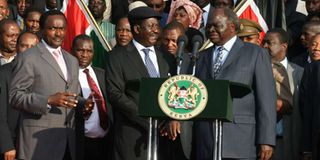How referendum changed political landscape

From left: Vice President Kalonzo Musyoka, Prime Minister Raila Odinga and President Mwai KIbaki before they addressed the nation from KICC, Nairobi, on August 5,2010 during victory celebration after the referendum in which the YES won.
What you need to know:
- The Raila camp’s No campaigns were bolstered by the entrance of Kanu to the ranks of the Orange campaigns.
- Kanu, smarting from loss of power in 2002 and led by Mr Kenyatta, was eager to teach the Kibaki regime a political lesson.
Electoral Commission of Kenya chairman Samuel Kivuitu walked into a press conference carrying two fruits that would redefine the political landscape of the country for years; a banana and an orange. It was a hot Tuesday afternoon on September 5, 2005.
The country was gearing up for a referendum for a new Constitution after decades of clamour for reforms. On the ballot box, Kenyans were to be asked; Are you for or against the ratification of the proposed new Constitution?
Those opposing the Constitution would use the Orange symbol and supporters would tick the banana at the ballot box. From then on, what were previously sources of vitamins became the source of tension and high drama that would culminate in the 2007 post-election violence, the worst the country had ever seen.
Mr Kivuitu chose the two fruits because they were not controversial and did not represent any political symbol.
“We choose something that is beneficial to all and can be easily remembered,” said Kivuitu. However, Roads Minister Raila Odinga said they would have preferred the use of a tick and a cross instead of the fruits. Then Kanu secretary-general William Ruto said the independent party also preferred use of colours, yellow to mean No and green or blue for Yes. But both leaders agreed to use the fruits for the referendum.
Causing indigestion
The referendum fruits were also causing indigestion in the Narc administration. Those supporting the Constitution were led by President Kibaki and ministers Charity Ngilu, Musikari Kombo and Vice-President Moody Awori. The Nos were led by Mr Odinga . It was one Cabinet, two opposing positions.
But the seeds of division were not sowed just by the draft constitution. It had everything to do with power sharing after the 2002 election. In the General Election of 2002, the opposition led by Mr Kibaki and Mr Odinga united to rout out Kanu, a party which had held political power since 1963.
The unity of Mr Odinga’s (LDP) and Mr Kibaki’s (National Alliance of Kenya) led to the formation of Narc, a political juggernut that toppled Kanu from power after four decades of power. LDP was mostly made up of former Kanu members who had walked out in protest after President Moi identified Uhuru Kenyatta as his successor, overlooking experienced. NAK was made up of oppositionists.
Lofty manifesto
But when the Narc coalition ascended to power in 2003, disagreements over a Memorandum of Understanding on sharing power that was not honoured rocked the party, leading to incessant fights among the two major groups that dimmed the hopes of millions who had banked on their lofty manifesto to lift them out of poverty.
The differences were now playing out in the referendum. The Raila camp’s No campaigns were bolstered by the entrance of Kanu to the ranks of the Orange campaigns. Kanu, smarting from loss of power in 2002 and led by Mr Kenyatta, was eager to teach the Kibaki regime a political lesson.
The Kibaki side favoured a watered down version of the original draft Constitution that retained an executive president with a weak prime minister. Raila’s No group preferred the draft proposed by the Constitution of Kenya Review Commission (CKRC) led by Prof Yash Pal Ghai that called for an executive PM and a ceremonial president.
The government, led by then Attorney-General Amos Wako, mutilated the Ghai draft and that was the document that was put to vote and supported by the Banana group. The Orange were opposing its enactment. The race was on.
The Orange movement managed to isolate Kibaki and his Mt Kenya base to run a more efficient propaganda campaign. President Kibaki had the money and government machinery, but the Raila group shone in messaging and mobilisation.
When the votes were cast in November 21, the results shook the political landscape to the core. Raila’s Orange team garnered 3.5 million votes against the Yes supporters’ 2.5 million. The Wako Draft was defeated and the Cabinet rebels were sacked. The campaigns spurned the formation of two parties and lay the ground for the 2007 election violence.





